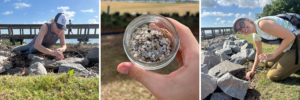What’s in our waterways?
While the best approach to reducing plastic pollution is to strengthen policies that will better help prevent different types of plastics from entering our waterways and littering the coastline, we can also take steps to remove plastic from our environment and collect data to help us learn what items are most abundant in our area.
One opportunity to get involved in advocacy on the local level is participating in litter clean-ups and citizen science projects, a way for the public to support local organizations with research. During clean-ups, volunteers can help record and count what types of plastic they find in the area. This data is then shared publicly and can be used to advocate for policies to limit pollution in the future.

For example, take a look at the numbers from a North Charleston litter cleanup last December by visiting Anecdata, a public data platform. Volunteers found over 2,000 pieces of litter in just two hours, including cigarettes, Styrofoam, plastic retail bags, and more! The Conservation League’s Land, Water & Wildlife team will use this data to support advocacy efforts in North Charleston by sharing with decisionmakers.
Preproduction Plastics
Another issue gaining attention in recent years is preproduction plastic pellets. Preproduction plastics are a type of microplastic particle, usually between one to five millimeters and are made of raw resin; these pellets are the precursor to larger plastic items, like water bottles, grocery bags, and polystyrene foam. Once these tiny, lightweight materials are spilled, they are virtually impossible to clean up, filling our land, waterways, and wildlife with microplastics and the toxic chemicals in them. This is why there are concerted efforts to regulate and limit spillage at the source.
In early May, volunteers participated in the first annual International Plastic Pellet Count, a global effort to illustrate the magnitude of the problem. In Charleston, the Conservation League and partners gathered in two locations to clean up our local waterways and identify where plastic pellet pollution is happening. Remarkably, the North Charleston crew collected a total of 746 pellets, while the volunteers in downtown Charleston collected a total of 2280 pellets!

Volunteers gather at Noisette Creek Pedestrian Bridge in North Charleston on the hunt for plastic pellets in May 2025.

